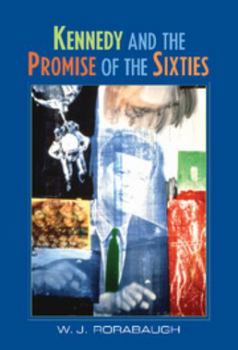Kennedy and the Promise of the Sixties
Select Format
Select Condition 
Book Overview
This book explores life in America during that brief promising period in the early sixties when John F. Kennedy was the U.S. president. Kennedy's optimism and charm helped to give promise to the times. At the same time, Cold War frustrations in Cuba and Vietnam worried Americans, while the 1962 Missile Crisis narrowly avoided a nuclear disaster. Early in the decade, the Civil Rights movement gained momentum through student sit-ins and Freedom Rides...
Format:Hardcover
Language:English
ISBN:0521816173
ISBN13:9780521816175
Release Date:September 2002
Publisher:Cambridge University Press
Length:342 Pages
Weight:1.45 lbs.
Dimensions:1.2" x 6.3" x 9.5"
Customer Reviews
2 ratings
AN OPENING CHORUS CLOSED?
Published by Thriftbooks.com User , 21 years ago
This is a short, well-written and most welcome history of prominent social, cultural and political developments during JFK's almost-1000 days, most welcome to persons like myself who graduated from college to "come of age" from 1960 through 1964, and who have seen our coming-of-age-time, over all, largely considered an un-event. The book was for me a memory lane experience and thank you, Mr. Rorabaugh, for unearthing us. Only tiny minorities of "us" were SDS or SNCC activists or right-wing radicals in college. Probably 98% of us were too torn by the hopes and disappointments you describe to commit to choices we correctly perceived would affect the rest of our lives. Even before November 22, 1963, the course the U.S. was following in Indochina was clear and either solidifed or undermined college students' career, or lack of career, choices. Graduating from a prestigious law school in 1966, I was in a (miniscule?) minority that temporised in effect and joined the black (and AIM) inspired, anti-war, sex-drugs-and-rock-and-roll, counter-culture. Not communists, then, certainly many of us became even more disillusioned than those millions five years younger whom we joined; we were probably more appalled, for example, when a Chicago Seven defendant became an insurance salesman. The only problem with your popular history, as I see it Mr. Rorabaugh, is that its Conclusion goes nowhere. Evidently you, or more likely your editors, were precluded by historical orthodoxy from asserting that the counter-culture of the middle sixties was a logical development from radicalism in Kennedy's times; and it was a Good and Necessary Thing; and if this GNT hadn't occurred, in 1968 we likely would have got not Nixon but Reagan.
Postmodernism Begins
Published by Thriftbooks.com User , 21 years ago
In KENNEDY AND THE PROMISE OF THE SIXTIES, Rorabaugh does a good job of supporting his thesis that the Kennedy administration, though short, was a critical era during which today's postmodern politics, culture, art and literature were born. In politics, it was Kennedy's reliance upon image marketing and private (his father's) money that undid the old backroom deals of the earlier political structure. Also, the civil rights movement came into new prominence in the March on Washington, the women's movement was reborn in its train, Pop Art replaced Abstract Expressionism, and Beat literature and the Folk music boomed. Rorabaugh credits the Kennedy administration for encouraging a break with the introverted, conformist world of the 50s -- giving tacit permission to a new extrovert culture where how one felt could be more freely expressed. It was an "inside out" time, he argues, which unleashed great optimism and creativity, but chaos and uncertainty as well. He neatly traces the early 1950s rumblings of political and social dissatisfaction against the bland bourgeoisie pursuits of money-making and family raising, showing how that earlier era set the stage for the early 60s explosion of the civil rights movement, and identity politics. He shows how the pursuit of social justice combined with the pursuit of radical non-conformity were tacitly endorsed during that era as an antidote to the anti-communist panics as practiced most famously by McCarthy and Nixon.But of course there was a darker side to the new "inside out" world Kennedy helped create: image politics were born -- a politics of money and marketing. He points out that Kennedy's platform was not a platform as much as it was a positioning against the previous administration. Kennedy merely promised he would "get the country moving again," talked provocatively of a (non-existent) missile gap. The Kennedy's used the media brilliantly and the media, especially television, used them. For the media recognized in Kennedy a perfect mythic story - Camelot - and could not get enough of Jackie, the kids, and the young president himself. In the photo spreads in LIFE, the White House tours on TV, the era of celebrity politics began.Rorabaugh is at his best in showing how the myths of the Kennedy image machine served to shield it from criticism then and now. Starting with the Bay of Pigs disaster followed by the Cuban Missile Crisis, Rorabaugh shows how an administration hypnotized by its press-clippings never had any real policies, but reeled from one crisis to the next. Rorabaugh suggests because of the administration's embarrassment in its dealings with Castro and Khrushchev, Kennedy talked tougher and committed more money to supporting the corrupt South Vietnamese government than was necessary or appropriate, and thus laid the groundwork for the disaster in Vietnam as well. The author also does a good job also of showing how Kennedy's love of intellectual brilliance and as his concentration





